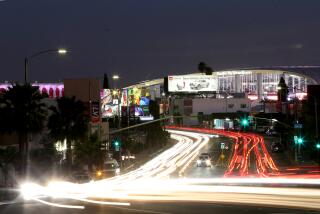Population of Lakewood Is Aging : Demography: Business must adapt to the older population if the community is to stay economically healthy, a city official advises.
- Share via
LAKEWOOD — The city’s population is aging, and business must adapt to the demographic change if the community is to stay economically healthy, said Chuck Ebner, the city’s director of community development.
“This is an older, grayer population than we’ve ever had and this is going to change the way we do business,” Ebner said Thursday at the annual Economic Forecast breakfast held by the city and the Greater Lakewood Chamber of Commerce.
Four years from now, 14.5% of the city’s population is expected to be 65 or older, according to projections from Donnelly Demographics, a marketing research firm that supplies census projections. In 1980, 7.6% of the 74,654 residents were 65 or older, according to U.S. Census Bureau data.
At the same time that much of the community is graying, Ebner said, the percentage of the population between 16 and 24 years old is shrinking. “There are less people for entry-level jobs in the labor force,” said Ebner, one of four speakers at the breakfast, which drew 140 people.
Census projections supplied by Donnelly show that the percentage of people in Lakewood between the ages of 15 and 19 will drop from 9.2% in 1980 to 6.2% in 1994.
Ebner said later that he emphasized the demographic changes because he wants local businesses to think about how they are going to adjust to an older market and a shrinking labor pool. Help-wanted signs have become permanent fixtures in some store windows, he said. Fast food outlets in the city, he said, are adjusting to the labor shortage by recruiting senior citizens as employees.
The graying population will also put a greater demand on City Hall for such public services as transportation and Meals on Wheels, Ebner said. Other speakers expressed confidence in the city’s economy.
The sprawling Douglas Aircraft Co. plant, which straddles the Lakewood-Long Beach border, may add another 1,000 workers this year to its 45,000-person payroll, said David A. Conlon, a Douglas senior staff executive. Employment at the plant is the highest it has been since World War II, when 52,000 workers worked at the plant, Conlon said.
The company’s payroll is $28 million a week, he said. “We obviously expect that to continue. That’s a lot of purchasing power,” he added.
The plant is producing the C-17 military transport plane and commercial aircraft for a domestic airline industry that is trying to replace an aging fleet.
Conlon said the company remains confident that Congress will continue its commitment to the C-17, although Secretary of Defense Richard Cheney said last week that he might recommend that the government cancel some of its orders. Such a change would have to be approved by Congress and the President.
The Pentagon initially said it wanted to buy more than 200 of the planes, Conlon said. The first C-17, a model expected to account for roughly 30% of Douglas’ earnings, is expected to roll off the assembly line later this year.
Douglas’ overriding concern, Conlon said, is to stay competitive and generate profits in an area with high labor and production costs. The median price for a house in Seattle, headquarters of Boeing Co., is substantially less than in the Southland, Conlon said. The state tax bite here is 38% higher for individuals than it would be in Seattle, he added.
“All of these things drive labor costs up, so we have to work harder to be more competitive,” he said.
Another speaker said sales at the Lakewood Shopping Center, which generates half of the city’s sales tax revenues, increased 11% last year and are expected to go up again this year.
But Mervyn’s and Bullocks department stores may move more slowly on plans to construct new buildings at the center, said Skip Keyzers, senior vice president of MaceRich Co. of Santa Monica, the center’s owner. The stores, which already are at the center, were forced to lower their prices last year to compete with price reductions by Federated and Allied stores, two chains that were acquired by Campeau Corp. The lower prices drove down profits, Keyzers said.
THE GRAYING OF LAKEWOOD
1980 1989 1994 (census) (estimate) (projection) Total population 74,654 77,050 75,980 Age 65+ 7.6% 12.6% 14.5% Age 15-19 9.2% 6.9% 6.2%
Source: Donnelly Demographics
More to Read
Inside the business of entertainment
The Wide Shot brings you news, analysis and insights on everything from streaming wars to production — and what it all means for the future.
You may occasionally receive promotional content from the Los Angeles Times.










